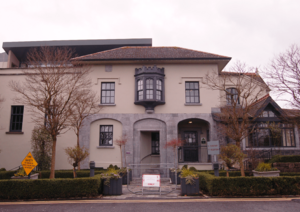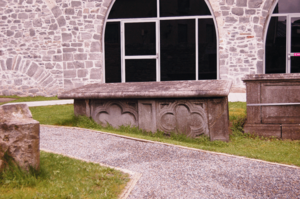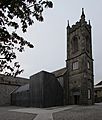William Robertson (Irish architect) facts for kids
Quick facts for kids
William Robertson
|
|
|---|---|

Rosehill House, where he resided until his death
|
|
| Born | 1770 |
| Died | 1850 Kilkenny
|
| Other names | William Robinson |
| Alma mater | Royal Dublin Society |
| Occupation | Architect |
| Spouse(s) | Catherine Jones |
| Parent(s) | William Robertson & Margery Jones |
| Awards | silver medal for drawing (1795) |
| Buildings | St. Canice's Church, Waterford Courthouse, Kilkenny Jail |
| Projects | Kilkenny Castle (remodelled), St. Canice's Cathedral |
William Robertson was a famous Irish architect. He was born in Kilkenny, Ireland, in 1770. He became known for designing many important buildings.
William studied at the Dublin Society. In 1795, he won a silver medal for his amazing drawing skills. This showed his talent early on.
After living in London for some years, William returned to Kilkenny. There, he designed several key buildings. These included the local Gaol (jail) and St. Canice's Church. He also worked on the Psychiatric Hospital.
He helped remodel the famous Kilkenny Castle. He also worked on churches like St. Mary's and St. John's Priory. His work wasn't just in Kilkenny. He designed buildings in other counties too, like County Cork and County Waterford.
Sometimes, people confused William Robertson's work with another architect, Daniel Robertson. But now, experts have figured out which buildings William truly designed.
William Robertson passed away on May 23, 1850. He died at his home in Rosehill, Kilkenny, which he had designed himself. He is buried with his family in St. Mary's Graveyard.
Contents
Growing Up in Kilkenny
William's father was also named William Robertson. He was from Scotland and moved to Kilkenny in 1765. He opened a plant nursery shop there. William's mother was Margery Jones.
There was a bit of confusion about William's last name. In some old records, it appeared as "Robison" or "Robinson." This was likely just a spelling difference back then.
His Time in London
When William was young, he moved to London. He probably worked for another architect there. His notebooks show he was very interested in buildings and gardens.
While in London, he showed off his drawings. One of them was a sketch of Kilkenny Castle. He also wrote two books. These books showed his interest in gardening, perhaps inspired by his father's business.
His books were about designing different types of greenhouses. They also showed designs for garden chairs, gates, and even small temples. These books were so popular that they were translated into French and German.
Family Life
In 1805, William Robertson married his cousin, Catherine Jones. She was from Clonmel. They were married for many years but did not have any children.
His Role in Politics
William Robertson had modern ideas for his time. He supported Catholic Emancipation. This was a movement to give more rights to Catholic people in Ireland.
He was also very involved in his community. He served Kilkenny as a justice of peace. He was also a magistrate and an alderman. In 1831, he even became the mayor of Kilkenny.
Building Ireland
William returned to Kilkenny around 1801. His first big project was designing the Kilkenny Gaol. He designed many private homes, including his own Rosehill House. He also worked on Jenkinstown House and Woodstock Estate.
He also helped design public buildings. These included the Courthouse in Kilkenny and the entrance gate to St. Kieran's College. He worked on several churches and even workhouses in Kilkenny and Carlow.
His Architectural Style
William Robertson often used a local stone called Kilkenny Marble. He liked the Neo-Gothic style for country houses and public buildings. This style often looked like old castles or cathedrals. It was probably inspired by the old buildings in Kilkenny where he grew up.
His own townhouses in Kilkenny looked more like the Georgian style. This style was popular in the 1700s and early 1800s. He used special windows called oriel windows in some of his designs. These might have been inspired by the ones at Rothe House.
He also used decorative shapes called quatrefoils. You can see these in his church designs and other buildings he worked on.
Gallery
Here are some examples of William Robertson's amazing work:
-
New Butler Gallery
-
Building of the Athenaeum on the Parade in Kilkenny, a floorplan is kept in Rothe House




















